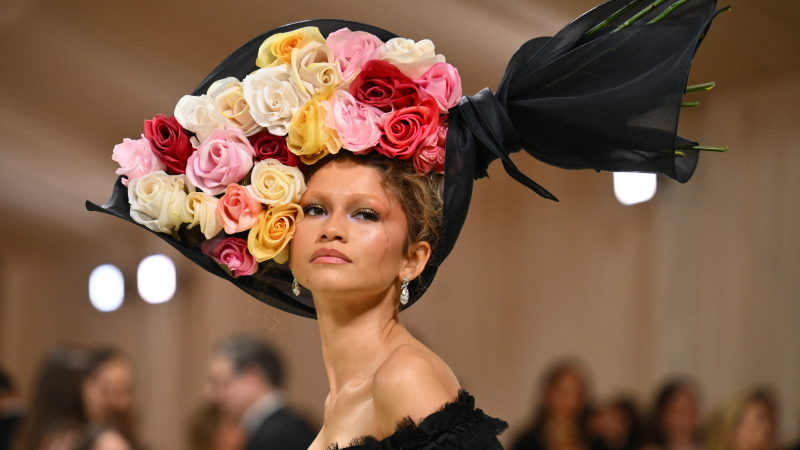Emma Chamberlin, Katy Perry and the 'no shirt' fashion trend and why young people love it
Emma Chamberlain, a YouTube personality known for her unwavering impact on minimalistic fashion in the mid-2010s, put a twist on “business casual” at designer Jean Paul Gaultier’s Haute Couture Fall 2024 show on June 26. Chamberlain, along with pop stars like Katy Perry, has taken minimalism to a whole new level by embracing the new “no shirt” fashion trend.
Last Wednesday, Chamberlain adorned a classic look with straight black trousers and a stiff, white button-down shirt. But at second glance, it was apparent that she wasn’t wearing the shirt, rather, it was attached to her body by two strings tied behind her back.
Over at the Balenciaga Fall 2024 couture show in Paris, Perry also stepped out on the red carpet with a bold look consisting of just black ripped tights and a long fur coat.
Whether you love or hate the look, young people are devouring this new trend. Body positivity movements, social media and an increased rebellion against traditional fashion norms have sparked this shift towards “more liberated and inclusive standards of beauty,” according to Carolyn Mair, cognitive psychologist, fashion business consultant and author of “The Psychology of Fashion.”
What is the 'no shirt' trend?
The “no shirt” trend goes a step further than the classic crop-top or even bra-top, and comes down to more body-barring looks like Perry’s.
Chamberlain explained her look on Jean Paul Gaultier’s official TikTok page, saying “it’s deconstructed, it’s taking the most simple, classic silhouette and turning it on its head, and there’s nothing I love more than that.”
Fashion historian and author Brian Centrone says the "no shirt" look is reflective of broader social and political issues regarding women's rights, particularly because exposing the breasts have "always been seen as taboo and forbidden."
"One of the ways in which women can push back against that is to show how they can be in control of their own bodies," Centrone says. "It's an amazing thing that young women are able to sort of stand up and say, 'This is me. I own myself.' And that's what fashion can do for us."
Weren’t we just in a 'no pants' era?
Yes, we were. First young celebs were ditching their pants, and now going topless has taken that trend's place.
"Fashion is just expressing what's going on broadly in culture," longtime business of culture journalist Christina Binkley previously told USA TODAY. "We're in a rule-breaking era."
"In a lot of these cases, they're not any more revealing than they would be if they were in a bathing suit," Binkley said. "It looks a little shocking to those of us who aren't accustomed to seeing that, but these are just rules that somebody made up at some point.”
Centrone says these bold trends aren't going away anytime soon.
"I think women will always be moving in the directions of these trends that highlight something about the sexualized nature of their body, and the ownership that they should be able to have over their body the way men do," he says.
Like the no-pants era, topless trends aren’t necessarily fronted by “revealing looks,” but by distinct changes that resonate with young people who want to steer off the beaten path.
“The embrace of bold, unconventional trends underscores the psychological drive to stand out, explore new facets of identity, and signal group affiliation or personal values,” Mair says.
What was the 'no pants' trend?Kylie Jenner, Hailey Bieber and more Gen Z stars spark 'no pants' fashion trend
Why are young people embracing this trend?
Young people are influenced by what they see in media and social networks, especially among celebrities they admire or recognize as key fashion influencers.
Adolescents also particularly impressionable to external influences, and this is “amplified by the constant exposure to these trends and the celebrities who endorse them,” Mair says.
This can lead to quick adoption of emerging trends to “stay relevant and accepted within their social circle,” according to Mair.
Young people also gravitate towards bold trends as a way to cultivate their identity, especially when they feel their voices are "not being heard, recognized, or taken seriously," according to Centrone.

"Fashion, as much as people like to say it's 'frivolous,' it's really not," Centrone says. "Fashion has a fundamental root in expressing ourselves politically, socially and even religiously within our societies. Young people can use fashion as a vehicle, as their voice, (which) at times can be louder than their own voice."
Mair says the accelerated turnover of fashion cycles have allowed young people to embrace more adventurous looks and highlight a cultural movement that prioritizes the celebration of personal identities and self-empowerment.
“The excitement also stems from the novelty and boldness of these trends,” she adds, “which offer a way to stand out and assert individuality in a rapidly changing social landscape where, currently, anything goes.”
Disclaimer: The copyright of this article belongs to the original author. Reposting this article is solely for the purpose of information dissemination and does not constitute any investment advice. If there is any infringement, please contact us immediately. We will make corrections or deletions as necessary. Thank you.






